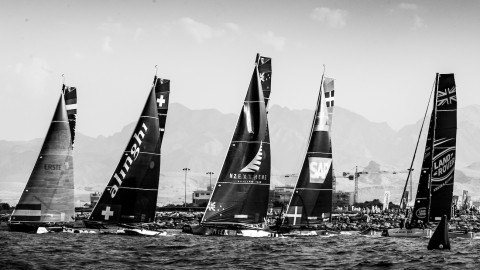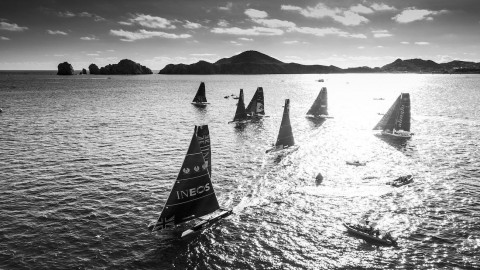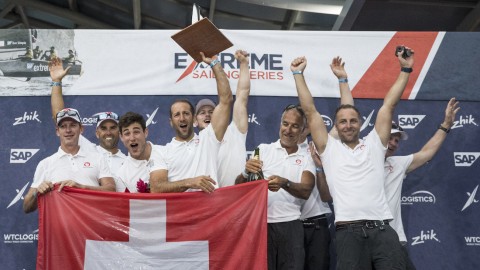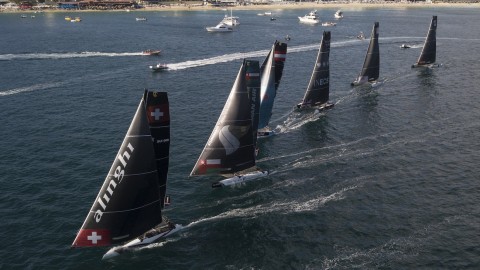Mid-season form
The Extreme Sailing Series™ has gone through a period of dramatic change this season as the world’s premier Stadium Racing circuit celebrates its 10th anniversary. An influx of fresh talent, new venues and a revised race format have all added to the hype, but the greatest evolution is the replacement of the Extreme 40 by a smaller, faster catamaran: the flying GC32.
Monday 22nd August 2016

The Extreme Sailing Series™ has gone through a period of dramatic change this season as the world’s premier Stadium Racing circuit celebrates its 10th anniversary. An influx of fresh talent, new venues and a revised race format have all added to the hype, but the greatest evolution is the replacement of the Extreme 40 by a smaller, faster catamaran: the flying GC32.
“The switch to foiling has been the biggest transition of the last 10 years”, commented Event Director Andy Tourell. “Halfway through the season with four Acts down, we have adapted the sporting format to maximise the venues for the GC32s to deliver intense competition on the water and commercial return for all stakeholders.”
Tourell continued: “The competition on the water has been fierce as the fleet have got to grips with flying. We’ve been able to open up some of our venues like Oman and China to really stretch the boats, and in Cardiff and Hamburg we have been able to race the foilers competitively and safely in stadiums.
“Looking at the second half of the season, St Petersburg will, once again, be testing the teams short course strategies within the Neva River, before re-incorporating longer courses in Madeira, Lisbon and Australia.”
Speaking about the race format, Tourell said: “With 16 race days and on average over 20 races per Act already completed this season, time on the water has been vital for all of the teams to get up to speed. That breaks down to more than five races a day, which gives the sailors the time they want on the water as well as providing a huge amount of entertainment for the public who come to watch, or the VIP guests who get a chance to race. This Series is the only one of its kind to offer such a high volume of races during each event.”
On the water, crews have had to master new, unfamiliar controls and learn new skills, including how to deploy and trim the foils, vital to making the boat fly. In terms of pre-season favourites, two teams immediately leapt out according to thedailysail.com editor James Boyd. Ernesto Bertarelli’s Alinghi and Morgan Larson’s Oman Air both bring with them valuable foiling experience, and have so far lived up to the pre-season expectations.
Larson’s crew of former Extreme Sailing Series champions have barely put a foot wrong this season. According to the SAP Sailing Analytics, they have finished in the top three in over 72% of the 83 races sailed so far – Alinghi are the closest to rival them at 53%.
What is the key to their success? “Accumulated experience on the Extreme Sailing Series from our entire Oman Air team, our drive to learn the GC32 and a very committed team,” Larson says. And the stats certainly back it up. The team flying the Omani flag has won over 36% of the races, giving them a higher average race score than any other team.
The only team to beat Oman Air to an Act victory so far is the Swiss-flagged Alinghi, who took spoils in Qingdao, and came tantalisingly close at Act 4 in Hamburg. But is it Red Bull Sailing Team with Olympic pedigree at the helm in Roman Hagara and Hans Peter Steinacher alongside as tactician, who is second in the Series rankings.
The Austrians may be newer to the foiling game, but they have got competitive quickly. The team has finished on the podium at every Act so far this year taking second in Muscat and Cardiff, and third in Qingdao and Hamburg.
Reflecting on the change in boats this season, Hagara commented: “The intensity on the water has increased. It’s more extreme. We like the boat and we like the competition in general. The GC32 is a great boat.”
For the Austrians it’s been a case of saving the best until last. Scoring big in the final double points race -they have won one double pointer and taken 22 points from a possible 24 at three Acts- has often meant a ‘down to the wire’ battle.
The team however have finished less than 50% of the races in the top three and Hagara knows his team will have to pull something special out of the bag if they want to clinch that top spot. “It’s all about sailing constantly in the top three,” commented Hagara. “This is our goal in each race, on each race day and at each event. This is what will count at the end of the year to be on top of the podium.”
On paper SAP Extreme Sailing Team have been fairly evenly matched to Red Bull Sailing Team. The Danish have finished 40 races in the top three, the Austrians 41; the Danes have won nine races, Austria 10. Co-skippers Jes Gram-Hansen and Rasmus Kostner are also on average the fastest team on the water, but have only made it onto the podium at one Act.
So what’s the key ingredient that’s been missing? “It is quite close with Red Bull Sailing Team on the points, which showed in Hamburg where we were on even points after 17 races. We got more podium finishes, but it all came down to the last double point race and the tiebreak rules,” commented Køstner.
“The first part of the season has been all about dialing in the new boat and get settings, trimming and manoeuvres right. From now on there will be more focus on doing the quick decisions right and fight for the favoured side of the racecourse.”
New to both foiling and the Extreme Sailing Series Stadium Racing format, CHINA One, Land Rover BAR Academy and Sail Portugal – Visit Madeira may be on a steeper learning curve than some, but all showed they have the necessary talent to get up to speed quickly.
CHINA One in particular have got better as the season has progressed. At Act 4 in Hamburg they scored on average over nine points (equivalent to fourth place) compared to eight points at Act 1 Muscat. As this team gets more familiar with the stadium format, it seems like a matter of when, not if, they will take their first Act win, with Morgan Larson tipping them for big things if they can lock in the same crew.
For the Portuguese flagged team, crew changes throughout the season have potentially slowed their learning curve, but in three-times Olympic competitor Diogo Cayolla, Sail Portugal – Visit Madeira have a strong leader from which to build a foundation for a competitive team in 2017. “The main aim was to build, in a medium term, a full Portuguese competitive team able to fight for victories in the Extreme Sailing Series.”
“In the first four events, we had four different crews, eight different crew members in which five sailed the GC32 for the first time this year. Realistically we all know that it is impossible to win in a set up like that, but we believe this is the only way to build a stronger team for the future.”
For the youth team Land Rover BAR Academy, losing helmsman and three-time Extreme Sailing Series winner Leigh McMillan after Act 2 Qingdao had an expected impact on their results. But the team is relishing the chance to learn in the fast paced-world of Stadium Racing, gaining valuable experience which will stand them in good stead for the second half of the season as they work towards emulating the success of their senior racers including Sir Ben Ainslie.
Next stop for the fleet is St Petersburg, Russia, as the fleet launches into the second half of the season.




